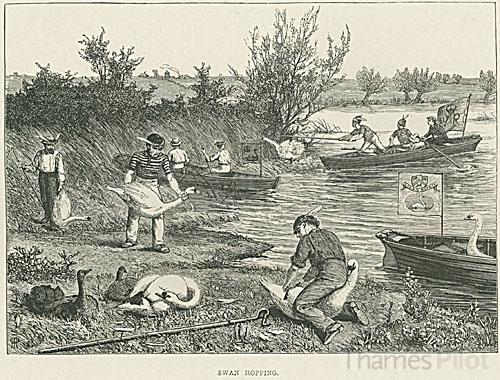
The third week in July is set aside for the annual swan count along the Thames.
“All swans – unmarked – in open water – belong to the [British] Crown, and have since the Twelfth Century,” says David Barber, Queen Elizabeth’s official swan marker for 16 years. Although, legally, the Queen retains ownership over all unmarked swans in the United Kingdom, the royal British monarch only exercises her rights over a 79-mile stretch of the Thames River. Barber’s job, with the help of a crew in boats, is to annually count the number of unmarked swans in the Thames. This tradition, called “swan-upping,” takes place over a 5-day period the third week in July.

Swan Upping Long Ago – the best way to tag a bird was to sit on it
The ritual [of swan upping] was first documented in the 12th Century, when the bird was a popular dish at medieval feasts. The monarchy laid claim to the birds, which were a valuable food commodity, and doled out ownership charters in exchange for favors. Up to the mid-1800s, swan marking was akin to cow branding: A unique mark, carved into the beak of a newborn cygnet, designated ownership by a specific, chartered family or organization.
Henry VIII reportedly enjoyed swan at his dinner table. Today, swan eating doesn’t go down so well with many Britons, who live in a country that Dr. Perrins describes as “bird oriented.” In 2005, the Master of the Queen’s Music, Sir Maxwell Davies, made headlines when he found a dead swan on his property and made a terrine of it. Mark McGowan, an activist artist, upset Britons when he ate swan in a performance protest against the queen in 2007.

A Swan Upping Boat on the River Thames in England today
This week, Mr. Barber’s crew counted and weighed roughly 120 newborn swans. When they come upon a brood, the rowers yell “All up!” and surround the birds with their skiffs. After deftly bringing the swans aboard, the uppers temporarily tie them up.
“The best way is to sit on the bird,” said Robert Dean, a boat builder and three-year veteran of the royal crew, who stood on the Eton dock Monday morning with a bundle of swan ties holstered in his belt. Once the newborn swans are weighed and tagged with identification rings, they are entered into the log and released into the river.
For the swans, it is a painless affair — and it has helped save their lives. In the 1980s, swan upping records helped alert Dr. Perrins to a sharp decline in the swan population on the Thames caused by lead poisoning from fishing weights. After a successful campaign to ban the implements, the number of mute swans returned to normal — about 35,000 across the country today, Dr. Perrins said.
The identification rings used by the swan uppers also assist local rescuers, who use them to return injured birds to their broods after treatment. Swan Lifeline, a local agency that treats about 1,100 sick swans each year, cures common injuries from fishhooks and dog attacks, as well more exotic wounds, as when swans fly through greenhouses accidentally. Working closely with Swan Lifeline, Mr. Barber coordinates the removal of as many as 100 swans before the Henley Royal Regatta on the Thames.” (1)

For the first time in her 57-year reign, Queen Elizabeth attended the launch party on July 20.
In the following youtube video, the Queen’s swan marker David Barber explains and demonstrates the practice of swan-upping.
(1) “In Her Majesty’s Service, Loyal Minion Courts,” The Wall Street Journal, July 24, 2009.


















